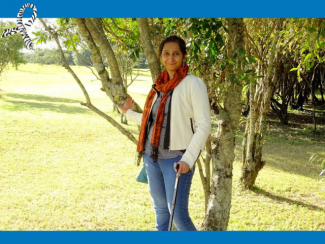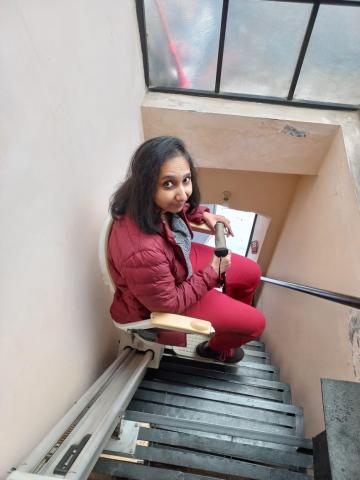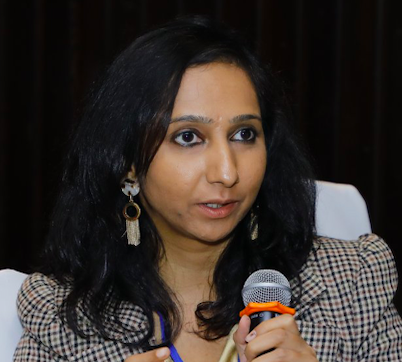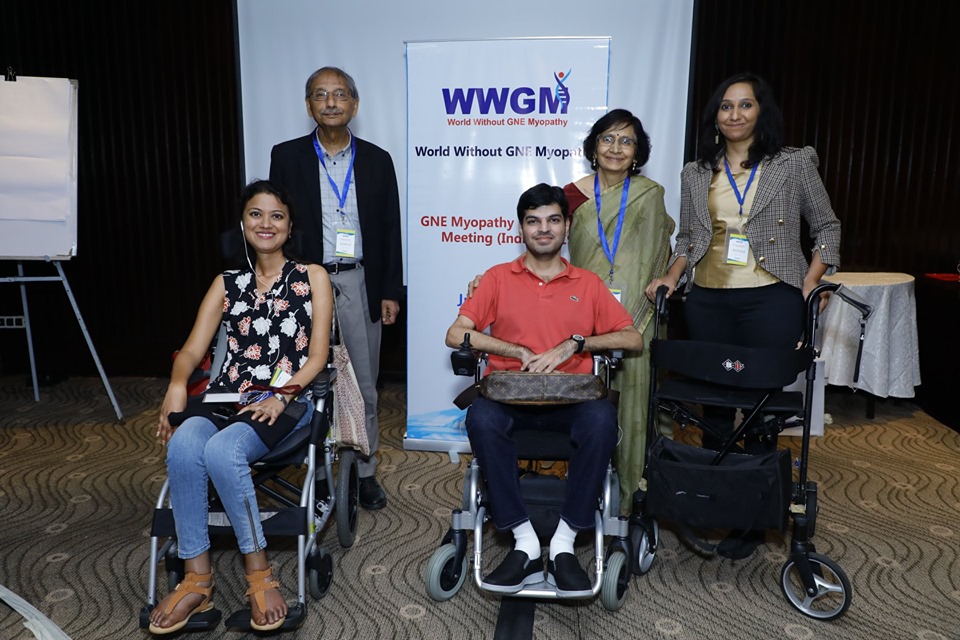
Prof. (Dr.) Shilpi Bhattacharya, diagnosed in the prime of her life with rare disease GNE Myopathy that weakens skeletal muscles, fought hopelessness and decided to take the illness by the horns to make a difference to herself and the rare disease community.
In 2009 at age 27 you were diagnosed with GNE Myopathy. Please could you tell us a little bit about this rare disease.
GNE myopathy is a rare disease that affects approximately 6 persons in a million. Symptoms generally start in the 20s or 30s. This disease causes the skeletal muscles of the body to become progressively weaker – so legs, hands, back and neck. The prognosis is that from 10-20 years of start of symptoms it requires people to become wheelchair users and ultimately quadriplegic. This is a genetic disease and occurs due to a mutation in the GNE gene. It can occur if both parents have one copy of the defective GNE gene.
What were your early symptoms?
I had some symptoms from early childhood like weakness in my fingers and a different walking gait but the symptoms really started progressing when I was 24. I started limping (because I had foot drop), my hips became weak and I couldn’t run and I had difficulty climbing onto high things like stools. I also started falling a lot. I would walk slower than others and got tired from walking. Then I had difficulty climbing stairs.

Pic above: Shilpi on her stair climber wheelchair
What tests did you have to undergo to determine GNE myopathy (GNEM)?
I first went through an MRI which was unhelpful as it was not a muscle MRI. I then went through a nerve conduction test (EMG), which was inconclusive as my nerve conduction is not affected. I was also misdiagnosed by the first neurologist I visited. The next neurologist I visited diagnosed me correctly but it took almost 2 years. I had a muscle biopsy, which was also inconclusive as the muscles in that region of my body were not showing signs of the disease yet. The conclusive test finally was the DNA test which showed mutations in the GNE gene.
Who is the specialist doctor to be consulted for GNEM?
A neurologist or neuro-muscular specialist should be consulted. One may also want to consult a physiotherapist, occupational therapist, genetic counsellor and psychological counsellor (if counselling is needed).
Adapting to life with a disability is never easy, especially when you have led a 'normal' life for over 25 years. How long did it take you to reconcile to your physical limitations?
For a long time I found it very difficult to talk about my diagnosis. I treasured my independence and was too scared to think about what would happen when I got worse. I would hide the braces (Ankle Foot Orthosis) I wore so no one could see them. It was only when my symptoms got really bad that I started acknowledging myself as disabled. In fact the first time I realised that others thought of me as disabled was when my PhD programme administrator told me that as a person with a disability I could get some additional funding in my fellowship. Till then I never even thought of myself as disabled.
It has been nearly ten years since your diagnosis. How has the illness progressed in the last decade?
Ten years ago, I got a scholarship to do a Ph.D. that required living in three different European countries in three years. So in the last 10 years I have gone from living independently in three foreign countries where I did not know anyone and taking solo travel trips abroad to being unable to walk on my own at all. I currently use a walker which really helps me to be independent but it has become difficult to get around on my own as I cannot walk without assistance and there is always a danger of falls. My hands and arms are also getting weaker so lifting things is a challenge.
Currently, there is no effective cure for GNEM. What do you do to manage your symptoms and slow down the progress of the disease?
I do yoga and meditation. I used to do hydrotherapy exercises as well but that has discontinued since Covid.
Your parents, both of whom are scientists, you and others have started a non-profit organisation - World Without GNE Myopathy (WWGM) - that deals with the rare genetic disorder. What are some of its activities for finding a cure?
My parents are eminent scientists with a number of scientific accolades under their belt. WWGM has worked hard to raise awareness of GNE myopathy in the scientific community in India and abroad so that more scientific research can be conducted towards a treatment for GNE myopathy. We have been one of the first rare disease groups to really push for developing treatments for rare diseases in India. We have organised a number of scientific conferences on rare diseases since 2016, a recent one in November 2020 was called Muscles and Diseases and it lead to the submission of a mega level translational scientific research project to the Government of India, which is currently being reviewed. The aim of this project is to develop affordable treatments for a few different rare muscle diseases in India using the latest scientific technology. We have also funded scientific research into developing treatments – particularly towards developing gene therapy. The two main projects we have funded are:
- Gene replacement therapy - Since GNE myopathy is a genetic disorder caused by mutations in the GNE gene, a direct therapeutic approach would be to introduce a normal copy of the GNE gene in patient muscle cells. We are supporting research in this area by funding Dr. Arkasubhra Ghosh, a pioneer in gene replacement technology at Narayana Nethralaya, Bengaluru.
- Cellular models of GNE myopathy - Before a drug can be tested in patients, it needs to be thoroughly tested in model systems, like lab-reared animals and cell lines. We are supporting the development of cellular models of human muscle cells carrying the GNE mutation. Stem cells are being generated from blood samples of GNE myopathy patients (funding to Dr. Kaushik Chakraborty, Narayana Nethralaya, Bengaluru). These cells will be further differentiated into muscle cells for which we are funding Dr. Ramkumar Sambasivan, a muscle cell specialist at the Indian Institute of Science Education and Research, Tirupati.
Our challenge has been to raise funds for our work as R&D requires tremendous funding. However, family and friends have been so generous in supporting us!
More details are available on our social media handles (@wwgnem on Twitter and @SupportGNEMyopathy for Facebook) and my personal YouTube channel.

Pic above: Announcement of approval of funding by ICMR for non-viral gene therapy
You are been working as a professor at Jindal Global Law School for several years. Could you tell us the joys and challenges of working.
Academics has been a lifelong passion. Teaching is immensely fulfilling and research gives me intellectual excitement and joy. My students are immensely supportive and loving. I look forward to each day because of how much I love what I do. My work place and employers / colleagues are extremely supportive and considerate. But working with a progressive disability is challenging as India still lacks the kind of infrastructure we see in other countries for people with disabilities.
People still do not understand the challenges of disability and that it takes ten times more effort to do simple tasks that everyone else doesn’t need to think twice about. Without a supportive environment it is absolutely impossible for someone with a disability like mine to be able to work and that is why we see very few or no people with disabilities in the academia anywhere. Working takes a lot out of me and comes at a cost because it’s absolutely exhausting at times. At the same time I feel our presence in a classroom can really uplift students and show them what is possible.
What drives you forward in life despite an unknown future?
I love the work I do for WWGM. A few years into my diagnosis I started feeling very helpless as some treatments that seemed promising did not succeed in clinical trials. It seemed to be pointless to be waiting around hoping for some miracle to happen without doing anything about it. It was obvious that given that this was a rare disease – nothing much was going on in terms of finding treatments and it was unlikely that someone would suddenly take interest in this disease and find a treatment for it. Those affected by the disease had to take matters into their own hands. At that time I decided that we have to be part of the change we want to see in life. That is what led to our starting WWGM.
While for many years I mourned this disease and how it changed my life, feeling like a victim never sat right with me. I felt I needed to take this disease by the horns and do everything I can to make a difference to the community. Over time my perspective to this disease has changed entirely. I feel it has really given me the ability to do things like being a patient advocate and helping the community, which I never would have done otherwise. I never thought of myself as a fighter but now I think I am one and I do not think of myself as lesser than anyone. This disease has given me immense strength and ability to face whatever it is that the future holds.

Pic above: Shilpi speaking at an event
What are your hobbies and interests that help you relax?
I don’t really get much time for that but I like to read and watch movies. I enjoy baking. I used to be a classical dancer before I had this disease.
How independent are you at home? Do you have a strong support system?
My parents are absolutely amazing! I would not have been able to do any of the things I have done in my life like a Ph.D. or this job without their constant and never-ending support of me. They always believed in me even when I doubted myself.
I am able to take care of my own needs at home but I find it difficult to take care of household chores. I love to cook but it is very tiring for me so I don’t do it regularly.
Is there a GNEM network of patients in India?
Yes, WWGM started a WhatsApp group of people living with GNEM in India. We also organise a yearly event that brings together patients with scientists and doctors to build a stronger GNE myopathy community in India. At these events we have sharing sessions and talks where the latest scientific developments are discussed and medical experts advise patients and answer questions. This has really helped to build a community. We also organise fundraising events for our scientific projects but events also help in awareness raising.
What advice would you give someone living with disability to overcome and grow?
I would say never let what others think/ say about you determine your own sense of who you are and what you want from life. Be confident, fight for what you think you deserve and believe in yourself. Let your disability be a source of strength. Do not treat your story as a source of shame but as a source of power and change.

Pic above: Shilpi far right, her parents standing and other patients with GNE Myopathy in wheelchairs at a WWGM meeting






